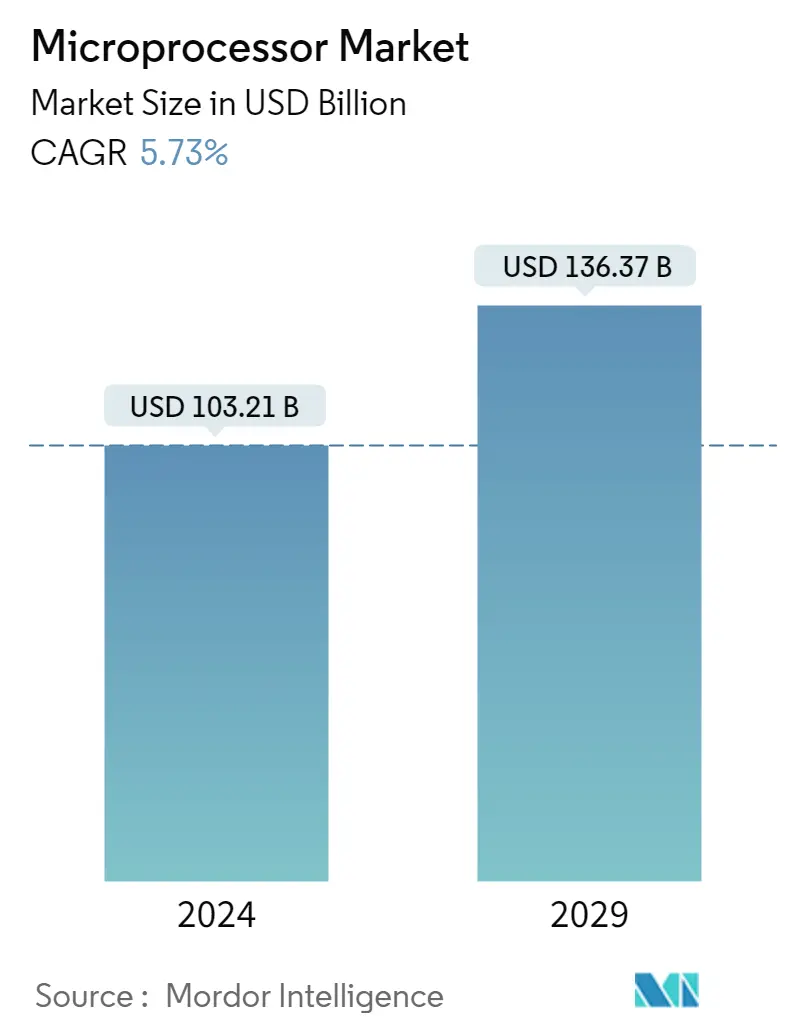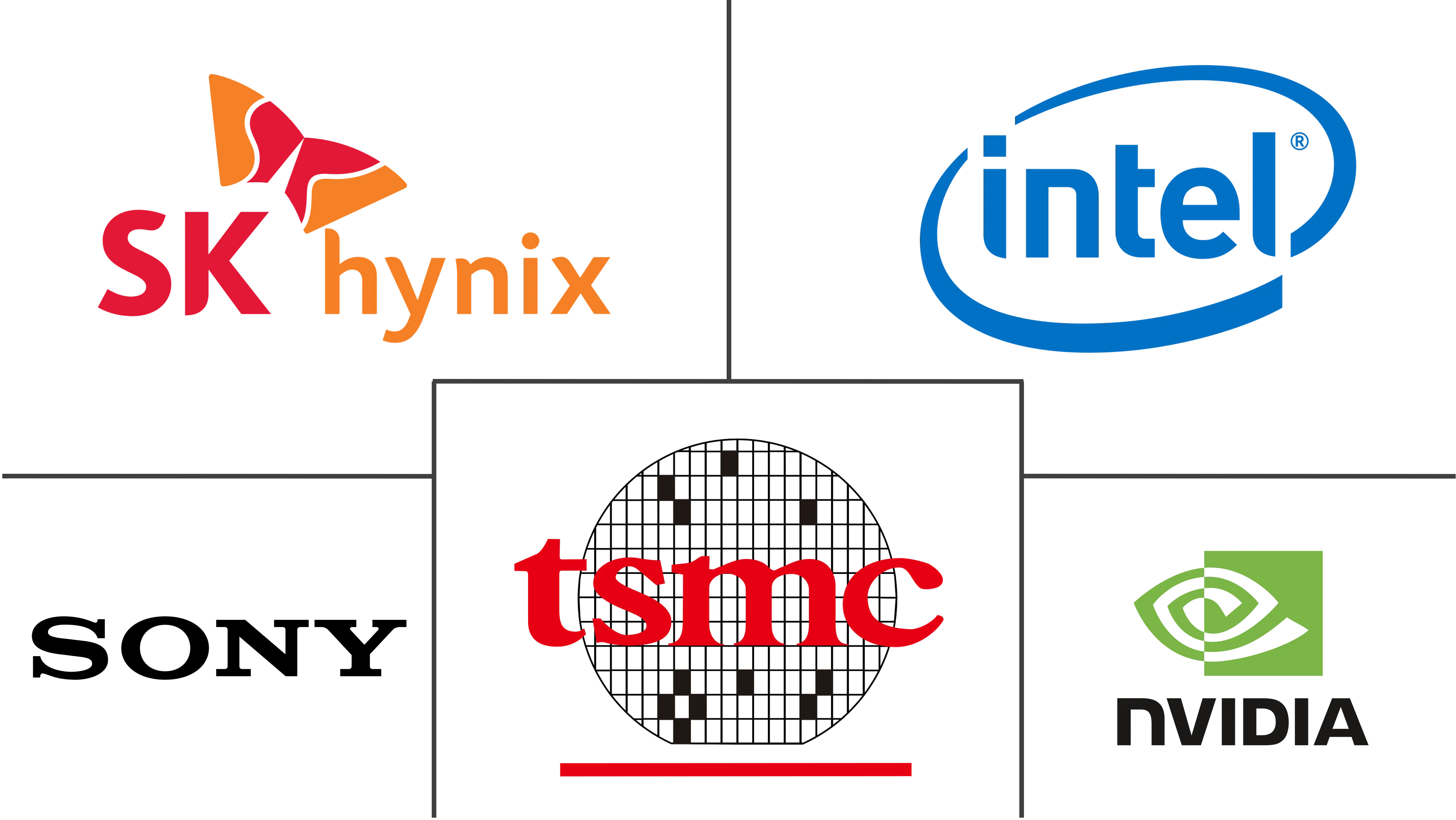| Study Period | 2021 - 2029 |
| Market Size (2024) | USD 103.21 Billion |
| Market Size (2029) | USD 136.37 Billion |
| CAGR (2024 - 2029) | 5.73 % |
| Fastest Growing Market | Asia-Pacific |
| Largest Market | North America |
| Market Concentration | Low |
Major Players*Disclaimer: Major Players sorted in no particular order |
Microprocessor Market Analysis
The Microprocessor Market size is estimated at USD 103.21 billion in 2024, and is expected to reach USD 136.37 billion by 2029, growing at a CAGR of 5.73% during the forecast period (2024-2029).
Due to the growing popularity of 5G and high-performance computing devices, increasing adoption of cloud-based software and data centers, advancements in artificial intelligence and machine learning solutions, and the increasing demand for household appliances and automobiles will likely fuel the microprocessor market growth.
- A microprocessor is a microcomputer's controlling unit, built on a chip, capable of performing Arithmetic Logic Unit (ALU) operations and communicating with other linked devices. A microprocessor comprises a Control Unit, a Register Array, and an ALU. The ALU performs arithmetic and logical operations; the Control Unit supervises data flow and instructions through the computer, and the Register Array stores accumulators and data. The microprocessor performs Fetch, Decode, and Execute in the provided sequence.
- The rapid rise of the Internet of Things is one significant reason for promoting microprocessor usage. As collecting data from a far wider range of things is now technically and economically feasible than before, companies frequently misjudge the complexity and volume of data generated by IoT products and platforms, necessitating the deployment of solutions to help them manage and interpret all of the data they are now collecting. Microprocessors which are among the major component of IoT infrastructure, are thus expected to grow in demand.
- In addition, the growing demand for Augmented Reality and Virtual Reality apps and devices, as well as digital cameras and gaming consoles, is propelling the worldwide microprocessor market forward.
- Apart from this, the increasing penetration of smart home products is also driving the demand for microprocessors. Devices like smart locks, fire, and smoke alarm systems, smart speakers, etc., are increasingly taking their place in the lives of people. Coupled with the increasing spending capacity of the middle class, especially across developing countries such as India, Brazil, etc., are expected to support the growth of the studied market further.
- The expanding data center industry is also expected to create a favorable scenario for the studied market's growth, as IT infrastructure, UPS (uninterruptible power supply) systems, power distribution units (PDUs), and cooling units all use microprocessors in some form or other. Furthermore, the multiple benefits of adopting micro-data centers, such as decreased transactional costs, high functionality, and high storage, are expected to propel the demand for such data center types, driving the studied market's growth in the process.
- However, the factors such as the shortage of semiconductor chips, the complexity involved in the production of microprocessor integrated circuits, circuit design expenses, escalating raw material prices, decreased shipment of computer systems, and increased sales of low-cost mobile devices are challenging the growth of the studied market.
- A notable impact of COVID-19 was observed on the microprocessors market. Although, the demand increased significantly during the pandemic, especially across the consumer electronics and healthcare industry. The vendors felt it hard to match the demand owing to limited production capabilities and supply chain constraints due to widespread lockdowns imposed across various countries.
- However, with the conditions returning to normalcy, the market is expected to gain traction as a significant portion of the semiconductor manufacturers is increasing their investment and efforts to scale up the production of microprocessors and other semiconductor products. Furthermore, the increasing penetration of technologies such as automation, connected cars, AI, ML, and IoT are creating a favorable market scenario for the growth of the studied market in the post-COVID period.
Microprocessor Industry Segmentation
A microprocessor is an electronic component built on a single integrated circuit (IC). It consists of millions of small components that work together, such as diodes, transistors, and resistors. This chip performs a variety of purposes, including timing, data storage, and peripheral device interfacing. These integrated circuits are found in various electronic products, including servers, tablets, smartphones, and embedded devices.
The Global Microprocessor Market will provide a detailed analysis of the industry for segments including Type (APU, CPU, GPU, FPGA), Application (Consumer Electronics, Enterprise, Automotive, Industrial), and Geography. The study also provides the impact analysis of COVID-19 on the market. The market sizes and forecasts are provided in terms of value (USD) for all the above segments.
| APU |
| CPU |
| GPU |
| FPGA |
| Consumer Electronics |
| Enterprise - Computer and Servers |
| Automotive |
| Industrial |
| Others |
| North America |
| Europe |
| Asia Pacific |
| Latin America |
| Middle East & Africa |
Microprocessor Market Size Summary
The microprocessor market is poised for significant growth over the forecast period, driven by the increasing demand for high-performance computing devices, the proliferation of 5G technology, and the rising adoption of cloud-based solutions. The market is also benefiting from advancements in artificial intelligence and machine learning, as well as the growing need for microprocessors in household appliances and automobiles. The Internet of Things (IoT) is a major catalyst for market expansion, as the demand for microprocessors in IoT infrastructure continues to rise. Additionally, the popularity of augmented reality, virtual reality, and smart home products is further propelling market growth. The expanding data center industry, with its reliance on microprocessors for IT infrastructure, UPS systems, and cooling units, is also contributing to the market's positive outlook.
Regionally, the Asia-Pacific area is expected to dominate the microprocessor market, driven by the increased use of smartphones, laptops, and other devices, alongside rapid digitalization and advancements in automotive electronics. China, in particular, is anticipated to maintain its dominance due to its robust consumer electronics and automotive manufacturing sectors. The region's growth is supported by government initiatives aimed at boosting the semiconductor industry, such as India's DIR-V program. Despite challenges like semiconductor chip shortages and high production costs, the market is expected to gain traction as manufacturers ramp up production efforts. The competitive landscape is characterized by a few major players, but growing demand and profitability are likely to attract new entrants, enhancing market competition.
Microprocessor Market Size - Table of Contents
1. MARKET DYNAMICS
-
1.1 Market Drivers
- 1.1.1 Increase in demand for high performance and energy-efficient processors
-
1.2 Market Restraints
- 1.2.1 Decrease in demand for PCs
2. MARKET SEGMENTATION
-
2.1 By Type
- 2.1.1 APU
- 2.1.2 CPU
- 2.1.3 GPU
- 2.1.4 FPGA
-
2.2 By Application
- 2.2.1 Consumer Electronics
- 2.2.2 Enterprise - Computer and Servers
- 2.2.3 Automotive
- 2.2.4 Industrial
- 2.2.5 Others
-
2.3 By Geography
- 2.3.1 North America
- 2.3.2 Europe
- 2.3.3 Asia Pacific
- 2.3.4 Latin America
- 2.3.5 Middle East & Africa
Microprocessor Market Research FAQs
How big is the Global Microprocessor Market?
The Global Microprocessor Market size is expected to reach USD 109.12 billion in 2025 and grow at a CAGR of 5.73% to reach USD 144.18 billion by 2030.
What is the current Global Microprocessor Market size?
In 2025, the Global Microprocessor Market size is expected to reach USD 109.12 billion.




